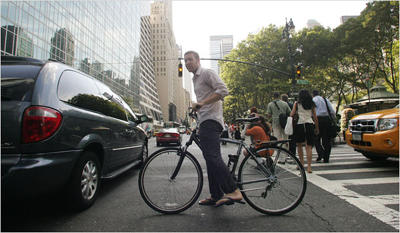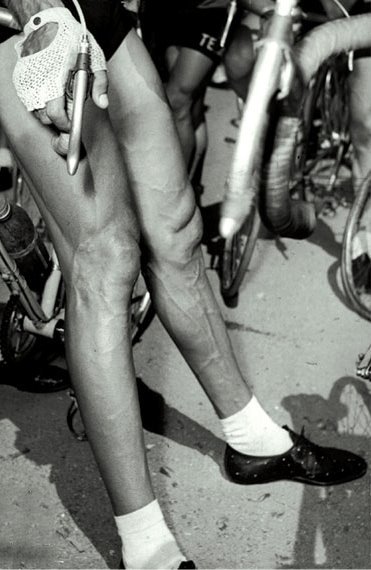The Times they are a Changin’
 Mon, August 18, 2008
Mon, August 18, 2008 In 1963 Bob Dylan wrote “The Times they are a Changin’.” I see the times a changin’ for cycling, I see it here in the US. Suddenly bicycles and cyclists are newsworthy.
Recently there have been a spate of cycling related articles in major newspapers. The LA Times did a story on July 21st, about cyclists and road rage.
The Wall Street Journal, no less, then ran with a story on the plight of the bicycle commuter in Los Angeles. Yet another article in The Economist, on cycling in the US, and then there was the piece in the New York Times that I mentioned in my last post.
Some of these stories dwell on negative aspects, increase in bicycle/car accidents, road rage, etc. But the media always dwells on the negative, it seems they can’t report a story any other way.
Placing this aspect aside, the main benefit I see in all this is that people are being made aware of bicycles and bike riders. Imagine the combined readership of these major publications, and how many people these stories reached.
People who otherwise may never have considered riding a bicycle to work, or for short errands; on seeing images of others doing just that, may think, “If they can do it, so can I.”
A recent story from Austin, Texas of cyclists being ticketed for running red lights, and for riding on the sidewalk, would appear at first glance to be anti-cyclist.
One of the main complaints used against cyclists, is that we don’t obey the rules of the road. It has become a cliché, one that will automatically be recited whenever someone mentions cyclists.
Enforcing the law for cyclists and being seen enforcing the law, will take away one very strong argument used against us by those who would rather we not be on the road. Enforcing the sidewalk law, takes away the argument that cyclist belong there.
I would much rather see bike riders voluntarily observe traffic lights, and not ride on the sidewalk. Let’s face it, if cyclists did just that, the action by police in Austin would be unnecessary.
In the accompanying video that runs with this story, is a shot of a bike commuter whining about motorists running red lights. Pointing the finger at other lawbreakers is always a feeble excuse for breaking the law.
Some may view the Austin story as another one of police anti-cyclist bias. Maybe so, maybe not; the question I ask myself is, in the long run will this be good for cycling. I believe the answer is yes, and it is already a good thing that stories like this get media attention.
The images on the video of what appears to be experienced cyclists, riding exactly as they should in traffic, I think leaves a good impression. Nowhere in the video do I see cars being inconvenienced by cyclists, and every bicycle on the road means one less car, actually easing congestion.
There are other signs of changing times. In Pittsburg, the City has announced plans to become bicycle friendly. They have started by appointing a cycling and pedestrian czar to oversee, and coordinate efforts to improve the lot of those who choose an alternative means of transport.
Could any of us imagined a few years ago that major US Cities would be even be thinking of accommodating bicycles, let alone making serious efforts, and spending money to do just that. We know that given time, other cities will follow.
Finally, I recently came across a blog by Tom Cassidy, who is a Chief of Police, in Lincoln, Nebraska. He posted a piece on cyclists titled Share the Road, in which he wrote:
Sharing the road is not just polite, it's the law. Bicycles essentially enjoy the same rights and responsibilities as motor vehicles on the public streets. Motorists need to accord bicycles the same right of way, following distance, and passing protocol that they would another automobile.
Refreshing indeed coming from a police chief. Tom Cassidy was once a cyclist and triathlete. He also commuted to work by bike for a decade.
Be happy that bicycles have become newsworthy. Bicycle related stories are the hot ticket right now, it won't last and bicycles will soon be "old news."
However, the media shapes public opinion and it may become cool and trendy to ride a bicycle, and it could become un-cool to harass or behave in an impolite manner towards a cyclist.
In the last verse of his song, Dylan wrote:
The line it is drawn
The curse it is cast
The slow one now
Will later be fast
As the present now
Will later be past
The order is
Rapidly fadin'.
And the first one now
Will later be last
For the times they are a-changin'.
 Dave Moulton | Comments Off |
Dave Moulton | Comments Off | 



















